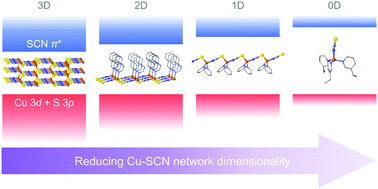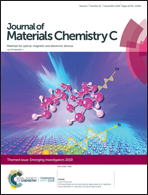Structural versatility and electronic structures of copper(i) thiocyanate (CuSCN)–ligand complexes†
Abstract
Copper(I) thiocyanate (CuSCN) is a promising semiconductor with an expansive range of applications already demonstrated. Belonging to the group of coordination polymers, its structure can be easily modified, for example via ligand (L) coordination. In this work, we have analyzed in detail the crystal structures of 26 CuSCN–L complexes that exhibit diverse structures changing from the 3D networks of the parent CuSCN to 2D sheet, 1D ladder, 1D zigzag chain, 1D helical chain, and a 0D monomer as well as intermediate bridged structures. We outline herein the basic structural design principles based on four factors: (1) Cu(I) geometry, (2) CuSCN : L ratio, (3) steric effects, and (4) supramolecular interactions. In addition, we employ density functional theory to study the electronic structures of these 26 complexes and find that the opto/electronic properties vary over a wide range, e.g., widened or reduced fundamental band gaps, restricted hole transport due to Cu–SCN network disruption, and the possibility of electron transport through the ligand states. We also observe a correlation between the electronic properties and the dimensionality of the Cu–SCN network. Lowering the dimensionality of the 3D structure to 2D, 1D, and 0D by increasing the number of coordinating ligands, the dispersion and the width of the top valence bands decrease whereas the energy difference between the Cu and SCN states expands. Aliphatic ligands in most cases do not generate electronic states in the band gaps whereas aromatic ligands give rise to states between the Cu and SCN states that lead to optical absorption and emission in the visible range. This study provides guidelines for developing coordination polymer semiconductors based on the Cu–SCN network. The 2D structure is identified as a promising platform for designing new CuSCN-based materials as it retains the carrier transport properties while allowing for properties tailoring through ligand coordination.

- This article is part of the themed collection: Journal of Materials Chemistry C Emerging Investigators


 Please wait while we load your content...
Please wait while we load your content...